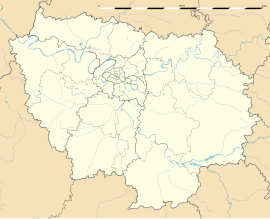
Bougival
Commune in Île-de-France, France / From Wikipedia, the free encyclopedia
Dear Wikiwand AI, let's keep it short by simply answering these key questions:
Can you list the top facts and stats about Bougival?
Summarize this article for a 10 year old
Bougival (French pronunciation: [buʒival] ⓘ) is a suburban commune in the Yvelines department in the Île-de-France region in Northern France. It is located 15.3 km (9.5 mi) west from the centre of Paris, on the left bank of the River Seine, on the departmental border with Hauts-de-Seine. In 2019, Bougival had a population of 8,790.
Bougival | |
|---|---|
 12th-century Notre-Dame Church | |
 Location (in red) within Paris inner and outer suburbs | |
| Coordinates: 48°52′00″N 2°08′00″E | |
| Country | France |
| Region | Île-de-France |
| Department | Yvelines |
| Arrondissement | Versailles |
| Canton | Le Chesnay-Rocquencourt |
| Intercommunality | CA Versailles Grand Parc |
| Government | |
| • Mayor (2020–2026) | Luc Wattelle[1] |
| Area 1 | 2.76 km2 (1.07 sq mi) |
| Population (2021)[2] | 9,031 |
| • Density | 3,300/km2 (8,500/sq mi) |
| Time zone | UTC+01:00 (CET) |
| • Summer (DST) | UTC+02:00 (CEST) |
| INSEE/Postal code | 78092 /78380 |
| Elevation | 23–166 m (75–545 ft) |
| 1 French Land Register data, which excludes lakes, ponds, glaciers > 1 km2 (0.386 sq mi or 247 acres) and river estuaries. | |
As the site where many of the Impressionists (including Claude Monet, Alfred Sisley, Berthe Morisot and Auguste Renoir) painted country scenes along the Seine, the town today hosts a series of six historical placards, known as the "Impressionists Walk", at locations from which the noted painters depicted the scenes of Bougival.[3]
Bougival is also noted as the site of the Machine de Marly, a sprawling, complicated[4] hydraulic pumping device that began supplying the massive quantity of water required by the fountains at Palace of Versailles in the late 17th century. Considered one of the foremost engineering accomplishments of its era, the cacophonous, breakdown-prone[4] apparatus comprised fourteen waterwheels (approximately 38 feet in diameter) driven by the current of the Seine — in turn powering more than 250 pumps, delivering water up a 500-foot vertical rise through a series of pumping stations, holding tanks, reservoirs, pipes and mechanical linkages. In use until 1817, the machine was subsequently updated, replaced with another pumping building in 1858 and finally replaced by an electrical generator in 1963. The building itself remained until 1968. Remnants are visible today at the riverbank.[4]
In Bougival, Georges Bizet composed the opera Carmen at his home on Rue Ivan Tourguenievf on the Seine,[3] close to where Russian novelist and playwright Ivan Turgenev had a dacha built, named Les Frênes (current-day Villa Viardot). A local monument commemorates the Montgolfier brothers, pioneers of flight;[3] the commune hosts the annual Festival of Bougival et des Coteaux de Seine.



